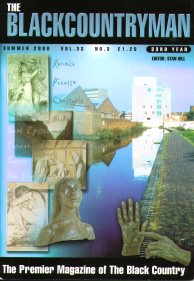 |
| Want
to go home click here... |
 |
| All
the latest news & events locally... |
 |
| Information
about the BCS... |
 |
| Articles
from around the local area... |
 |
| Information
about membership to the BCS... |
 |
| Review
of the Blackcountryman... |
 |
| links
to other sites you may find interesting... |
 |
| Publications
you may also find interesting... |
 |
| 10
things you didn't know about the Black Country |
 |
| Information
on how to contact us... |
|
 |
 |
| Season:
Summer 2000 |
 |
| Vol:
33 |
| No.
3 |
| Year:
2000 |
| |
| Editorial: |
It is a great pleasure to present in this issue a profile of Johann Van Leerzem whose name will already be known to readers for his articles about the supply of that basic, taken-for granted essential item in our lives, clean water. His late entry into the realms of University guided research and years of study are to be rewarded by the University of Wolverhampton with a well deserved academic reward.
In 1991 I took Noel Brettel (Lye born, distinguished South African writer, BC Personality No. 13 in Vol. 24 No. 4 of The Blackcountryman) to the Black Country Museum and he was thrilled to see recreated there examples of the old Black Country he remembered from his childhood from 1908. He had emigrated to Southern Rhodesia in 1930 to teach and observed there a different sort of hardship from that which he had seen in the Black Country. In later correspondence he reflected upon his Museum visit which had been a high point in his rare holiday in Britain, and though many of the exhibits had excited him, on reflection, he thought that it was all too clean. He remembered a poverty stricken, rough, dirty, semi-rustic environment.
Well, of course the museum is clean. Who would want to visit a dirty museum? For those who want to know what life was really like for many people vivid accounts in books by Kathleen Dayus (about Birmingham) would be enlightening. In this issue, on this theme is a vivid, cheerful account by Roy Cook of what life was really like in a poor post-war Black Country hoke. I first met Roy in 1948 and after 50 years found him just as cheerful and happy as I remembered him as a 15 year old, and still with fond memories of his happy childhood, tough though life was.
In the interests of authenticity, the author of "Black Country Pits above and below ground and what they were really like" suggested that 2 tons of horse manure be deposited in the Black Country Museum mine experience to create the true atmosphere. Thankfully that did not happen. Most people prefer to view the sanitised version of old Black Country life as depicted now at the Black Country Living Museum. Realistic accounts of what life was really like for many: earth kitchen floors, rats in the chimney breast, bugs behind the wallpaper, party lavatories, shoe repairs with cardboard, swimming in the canal, are available for those who, after a Museum visit, need to 'complete' the experience.
I hope that all readers will find items to interest them in the general reminiscences, accounts about our industrial heritage and general items. In the Reviews section there are details of books which I hope will make some readers reach for their cheque books, and there are the regular features.
Stan Hill
|
| 10
things you can read about in this month's issue: |
| BC Personailities - Johann Van-Leerzem - Stan Hill |
| The Dome of Discovery for the 1951 Festival of Britain - John S Allen |
| Dudley Grammar School in the 1950s - Geoffrey Gill |
| From Victoria's Yacht to Bilston Theatre Royal - John Beck |
| Noah Hingley Part 2 (1939-45) - Kenneth Mallin |
| Wednesbury Remembered - John Lester |
| John Cochrane's Woodside Works - Dudley - Peter J English |
| Bill Wheale and Frederick Price - John Sparry |
| Four Churches - Geoff Warburton |
| From West Midlands to West Tamar - June Ryan (nee Ellis) |
| |
|
|
|